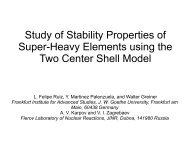The strange formula of Dr. Koide
The strange formula of Dr. Koide
The strange formula of Dr. Koide
Create successful ePaper yourself
Turn your PDF publications into a flip-book with our unique Google optimized e-Paper software.
Form leptons to quarks and neutrinos<br />
Due to its success with leptons, it was quite obvious that <strong>Koide</strong> and others<br />
would try to extend the mass <strong>formula</strong> to quarks. In order to see how this can<br />
be done in a physically meaningful way, let us first remove the square roots<br />
from Eq. (1). Indeed, there is a large consensus that “mass” is at least in part<br />
due to self-interaction processes which lead to expressions that are quadratic<br />
in some underlying classical or quantum field, and thus in the corresponding<br />
coupling constant. For instance, in classical electrodynamics: ∆m = e 2 /r,<br />
in general relativity: ∆m = Gm 2 /r, and in field theory: ∆m = g 2 |Ψ| 2 . This<br />
is also the case in pure field theories such as Lanczos’s [15] and Weinberg’s<br />
[16], where mass is entirely originating from the self and mutual interactions<br />
<strong>of</strong> fields.<br />
It is therefore natural to introduce a physical quantity that is more fundamental<br />
than the mass, which we propose to designate by the symbol ,ג i.e.,<br />
the third letter in the Hebrew alphabet, 2 and to define it as the gim <strong>of</strong> the<br />
particle according to the identity m ≡ ג 2 . This enables to rewrite <strong>Koide</strong>’s<br />
<strong>formula</strong> as<br />
(2) , 2 ) τ ג + µ ג + e ג) = 2 3 τ) 2 ג + µ 2 ג + e 2 ג)<br />
or, by combining the gims <strong>of</strong> the three lepton into the vector ⃗ ג) = ג e , ג µ , ג τ ) ≡<br />
( √ m e , √ m µ , √ m τ ), as the more compact expression<br />
(3) , 2 ) ג (Tr ⃗ 3 = 2 2 |ג ⃗ |<br />
where the trace operation Tr acting on a vector is to be interpreted as the<br />
sum <strong>of</strong> its components.<br />
In order to apply Eq. (3) to quarks, as well as to neglect the question <strong>of</strong><br />
radiative corrections already alluded to in the previous section, one has to<br />
circumvent the problems that their masses are not directly measurable, and<br />
that their estimated masses are obtained by methods which are different for<br />
each generation <strong>of</strong> them [17].<br />
One possible approach is to use some reasonable model, such as the<br />
Nambu-Barut [18, 19] <strong>formula</strong> generalized by Gsponer and Hurni [20] which<br />
gives a smooth and consistent fit to both the lepton and quark data, except<br />
2 Being the positional equivalent to “gamma”, the letter ג is called “gimel.” It means<br />
“camel,” and is thus a nice word for the carrier <strong>of</strong> the mass.<br />
3



